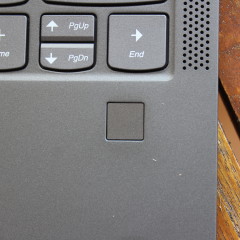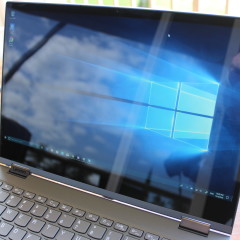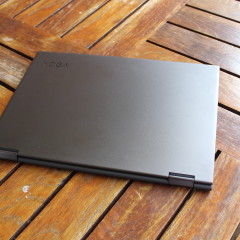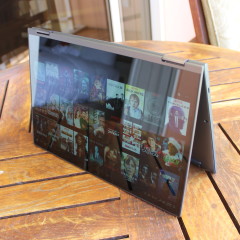Lenovo's Yoga C630 is probably the best Windows on ARM device, depending on what you're looking for. There are only two PCs on the market to use Qualcomm's latest chipset, the Snapdragon 850, with the other one being the Samsung Galaxy Book2.
I reviewed the Galaxy Book2 a couple of months ago, and indeed, it's a lovely device, especially with its Super AMOLED display. It's a tablet with an attachable keyboard, as are most Windows on ARM PCs, and it's not a form factor that I prefer. I want a convertible laptop, which is what the Yoga C630 is. It has a full keyboard that doesn't flop around like an attachable keyboard, a 13.3-inch display, pen support, and more.
The other key point in Lenovo's Yoga C630 is that it has 8GB RAM, while the Galaxy Book2 only has 4GB RAM. This part is key.
You'll notice that I haven't compared it to any of the original Windows on ARM PCs, which had a Snapdragon 835. That's because those devices were simply awful. I've noted this to Qualcomm too, in those words, and I was told that they know, but it was a starting point, which is completely understandable.
Specs
| Chipset | Qualcomm Snapdragon 850 |
|---|---|
| GPU | Adreno 630 |
| Display | 13.3” FHD IPS (1920x1280), 300 nits |
| Body | 12.08 x 8.52 x 0.49-0.51" (306.8 x 216.4 x 12.5-12.95mm), Starting at 2.6lb (1.2 kg) |
| RAM | 8GB LPDDR4X (soldered) |
| Storage | 128GB UFS 2.1 |
| Battery | 60Wh (up to 25 hours) |
| Ports | (2) USB Type-C Gen 1 (one port for power delivery only) (1) Nano SIM card (1) Microphone / headphone combo jack |
| Windows Hello | Fingerprint |
| Material | Display cover: Aluminum Bottom: Aluminum/magnesium |
| OS | Windows 10 Home in S mode |
| Price | $939.99 |
Note that the price is from Lenovo.com. At one point, Best Buy was selling it for $699, or $599 on a Verizon contract, but that deal seems to be gone. I do expect prices to go down though. Qualcomm recently introduced the Snapdragon 8cx chipset, also saying that Snapdragon 850 devices will be for the mid-tier, and the firm is aiming for a ~$500 price point.
The Yoga C630 comes in three tiers. $859.99 will get you 4GB RAM and 128GB storage, $939.99 will get you the model outlined above, and $999.99 will get the same but with 256GB storage.
Day one
Apps
When talking about Windows on ARM, or Windows on Snapdragon, an important topic is apps. These PCs can run x86 apps through emulation, and they can obviously run native ARM and ARM64 apps. What they can't run are x64 apps.
The Yoga C630 also ships with Windows 10 Home in S mode, meaning that it only runs apps from the Microsoft Store. Most UWP apps have a native ARM build and even packaged desktop apps will usually be supported for x86 emulation. Some apps, like Adobe's Photoshop Elements, are x64-only and you won't be able to install it.
Switching out of S mode and upgrading to Windows 10 Home is free, and this device will probably run all of the apps you want. The question is if it will run them well, and the main pain point is still with browsers. Edge runs natively on ARM, but Chrome and Firefox do not. Browsers generate code while they run, making them hard to cache.
Qualcomm did announce last month that Chromium and Firefox are going to be supported for native ARM64, and I was hoping to hold off on writing this review until they're available, at least in nightly channels. But it seems that they're not coming in the very immediate future. I've seen the two browsers in action though and they look fast.
Design
For all intents and purposes, the Lenovo Yoga C630 is a pretty basic design. There's nothing flashy about it, but it's functional. It's made out of aluminum and magnesium, and it comes in one color: Iron Grey.

On the top-left corner of the lid, there's the Yoga logo, which is pretty standard for Yoga-branded machines. It's not the same across the board though, considering that Lenovo has changed its branding. Yoga doesn't mean convertible anymore, and that's now indicated by the 'C' in C630. For example, a Yoga S630 would just be a clamshell.

The one thing that the Yoga C630 is really lacking is ports. On the left side, there's only a USB 3.1 Gen 1 Type-C port and a nano-SIM slot. On the right side, there's another USB 3.1 Gen 1 Type-C port, along with the power button and the 3.5mm combo audio jack.

Unfortunately, the device does not have Thunderbolt 3, nor does any Snapdragon PC. It's not supported directly by the chipset. I'm told that it's simply because that's an Intel thing.

There are two hinges attaching the display to the body. On the inside of the device, the left hinge has the Lenovo logo, which is pretty stylish branding, in my opinion. On the left and right sides of the keyboard, there are dual speakers, which is fantastic. The speakers fire right up at you, although it doesn't work as well when using the PC as a tablet, as the speakers are then firing away from you.

On the bottom-right of the keyboard, there's a fingerprint sensor for Windows Hello. Unfortunately, there's no IR camera for facial recognition, which was included in Lenovo's first Snapdragon PC, the Miix 630. I prefer facial recognition for Windows Hello, as it's just more natural to have a PC recognize me when I sit in front of it.
Display
The Lenovo Yoga C630 uses a 13.3-inch 1080p touchscreen, which is good in some areas and not great in others. Starting with the good, the screen is bright, the colors are accurate, and there was no light-bleeding. I also appreciate that it has narrow bezels on the sides and a slightly larger bezel on top, offering a somewhat immersive experience for a mid-range device.

There are two main things that I do not like about the display. One is that it's too glossy, making it a pain in bright sunlight. The larger issue here is that a selling point of Windows on ARM is cellular connectivity, which means that it's meant to be used on the go, or possibly outdoors.
The other thing is that it feels cheap to the touch. It actually reminds me of the LG gram, which I reviewed back in June. The biggest problem here is that it's pretty uncomfortable to use with a pen. I often take handwritten notes on convertibles, and when I tried to do so with the C630, I ended up switching to another device. It's worth noting that the C630 does not come with a pen in the box; you'll need to buy that separately. If you don't use pens, then the display is mostly fine.
In fact, 95% of the time in my usage, the display was great. I'm not typically using a PC outdoors, and I'm not typically using a pen. It's those rare cases that were kind of annoying.
Keyboard and trackpad
Without a doubt, a solid keyboard is the number one feature that I look for in a laptop, and I absolutely love both the keyboard and the trackpad on the Yoga C630. With shallower keys than on a ThinkPad, the keyboard is still comfortable to type on.

But what I really love is just how quiet the keys are. I'm something of a loud typist, so this is always appreciated. It's actually one of the quietest keyboards that I've used, and that's saying something.
The clickable trackpad is quite large as well, another thing that I love about this device. All-in-all, the input experience as a whole is wonderful.
But most importantly, it's a real keyboard, and a good one. As I noted earlier, most of the Windows on ARM devices released to date are tablets with attachable keyboards, and that's really not my thing. I prefer convertibles instead, because they can be used as real laptops that I can actually use on my lap.
Always connected and always on
The main value propositions to Windows on ARM are that it gets better battery life, it's always connected, and it's always on. We'll get to the battery life in a bit, but I want to talk about the latter two.
Always connected means that this device has 4G LTE. It has a Snapdragon X20 modem built into the chipset, so it can support speeds of up to 1.2Gbps, not that your carrier is likely to deliver those kinds of speeds in your region. And yes, there are cellular Intel PCs as well, although for those, connectivity always comes at a premium.
Since Qualcomm builds the LTE modem into the chipset, every Windows on ARM PC is an Always Connected PC, and it's fantastic. Seriously, it's amazing, and every PC should have cellular connectivity built into it.

I've seen the naysayers, pointing out that you can connect to public Wi-Fi in most places, or use your phone as a mobile hotspot. Those naysayers are missing the point. 4G LTE is more secure than public Wi-Fi, but for me, it's all about convenience.
Most public Wi-Fi networks have some kind of sign-in screen that you have to work through to get connected, whether it's Starbucks and its annoying form asking for your email address so you can get promo emails, or if it's a hotel asking you to prove that you're actually a guest there. If not, it could be an airport lounge where you have to locate the password. Sure, these are all minor annoyances, but in my opinion, the best features are the ones that solve those little annoyances. With the Yoga C630, you just turn on your PC and you're connected to the internet.
I truly believe that in 2019, all of our devices should be connected to the internet all the time.
And then there's the fact that it's always on. Well, that's what Microsoft and Qualcomm call it. It's not literally always on, as you can power it down. This simply means that when you wake up the device from standby, it actually wakes up.
This is something that doesn't always happen with Intel PCs and it's another one of those small annoyances. Sometimes I'll open up an Intel PC, press power, and the keyboard backlight will come on but the screen won't. I'll wait a few seconds and press power again. But wait, the screen came on a split second before I press the power button, so I just put it back to sleep.
Ever been there? Well, you don't have to worry about that with a Snapdragon machine because it just wakes up when you press that power button, just like your phone does.
Performance and battery life
I really, really wanted to hold off on this review until Firefox and Chromium are available for native ARM, but sadly, I don't know for sure that they're coming soon. We'll definitely be revisiting this though.
That's still the biggest weak point for Windows on ARM though. I, like many others, use Chrome to not just browse the web, but to work. The impact on performance is not negligible, but the good news is that it's at least usable. One thing that I noted in my review of the Miix 630, a Snapdragon 835 PC, was that it wasn't really usable, and that's a big change.

Other applications run fine. Adobe's Creative Cloud apps are x64-only, so I never tested those. Hopefully, Adobe will go native ARM at some point, although you're not going to be using Premiere Pro any time soon. More likely, you'll be able to use apps like Acrobat, Photoshop, and Illustrator though. You also can't go and play AAA games, if that's not entirely obvious.
This machine is really made for productivity on the go. Microsoft Office runs great, although that runs natively. It's really just emulated browsers that present a problem, and it's not that bad. Once native ARM browsers are out, and they're definitely coming, they'll probably do just fine.
The battery life is pretty great as well. Lenovo promises 25 hours of battery life from the Yoga C630, and as is the case with most Windows laptops, that's a bit of a stretch. What I can tell you is that if you use this machine for a full workday, you'll still have over 50% battery left when you leave. Once again, it's those little annoyances that this aims to solve, like having to bring a charger with you. Just yesterday, a friend asked me what kind of charger I had with me so she could charge her laptop, and I got to tell her why I didn't have one at all.
There are several reasons why you get better battery life with a Snapdragon 850. For one thing, it's just a more efficient chip, using RISC architecture. Also, performance and power consumption are divided into different cores for different tasks. There are high-power cores for high-power tasks, and low-power cores for tasks that don't need as much power, such as syncing notifications in the background. This is also why it can remain in standby using very little battery.
The other reason is Windows 10 Home in S mode. I'm told that S mode reduces battery usage by 15%, so this is part of the equation, and you lose that by upgrading to Windows 10 Home. I've not been able to find a solid answer for if you get the same battery improvements after switching out of S mode, but if you stick to Store apps.
It's worth noting that there doesn't seem to be any way of switching back to S mode, as I haven't been able to find a recovery image. Microsoft doesn't even include ARM64 in the Windows 10 Media Creation Tool.
Conclusion
I love the Lenovo Yoga C630, but the truth is that I wouldn't buy it for $939.99. I love it because I believe in Windows on ARM and I'm excited to see it in an actual convertible form factor, and also because I believe in 4G LTE connectivity on PCs. I also absolutely love the keyboard.

The price is oddly high for obvious reasons, such as the fact that you only get 128GB of storage and you can definitely get a better Intel-based PC for that price, although it wouldn't get you the benefits of Windows on ARM that I described above. You'd definitely have better performance though. But there are less obvious reasons, such as that Best Buy was selling it for $699, or $599 with a Verizon contract, but that listing seems to have disappeared. $699 is actually a pretty reasonable price for this device.
Qualcomm also recently announced the Snapdragon 8cx, which is meant to compete with an Intel Core i5. That should also drive down the price of Snapdragon 850 machines. At the end of the day, the Yoga C630 is definitely a buy, especially if things like battery life and connectivity matter to you, but you should really look for a deal on it before you shell out close to a thousand dollars. Your local Best Buy might still have them in stock at the old price.




















5 Comments - Add comment